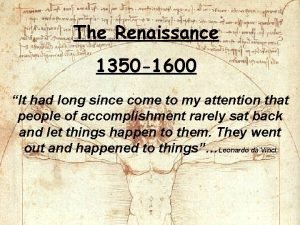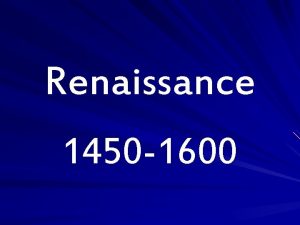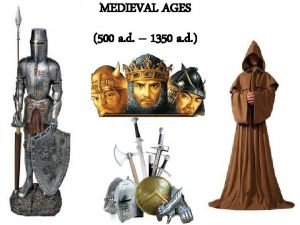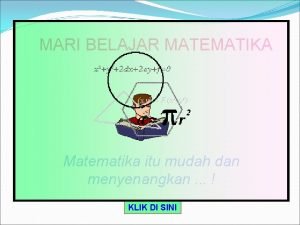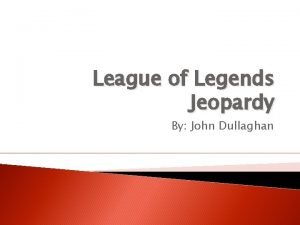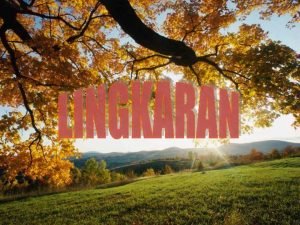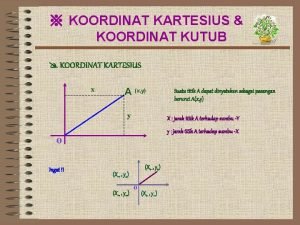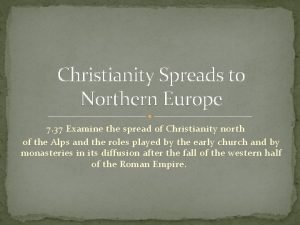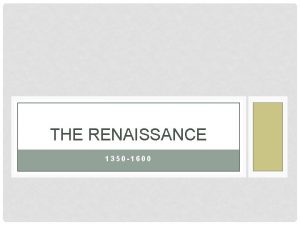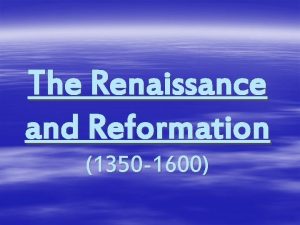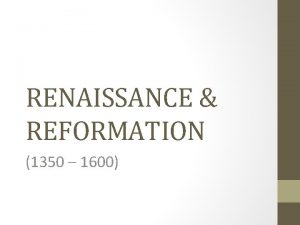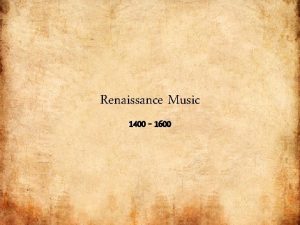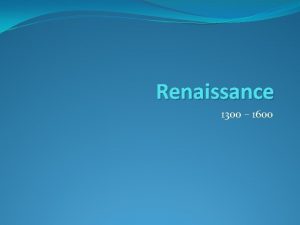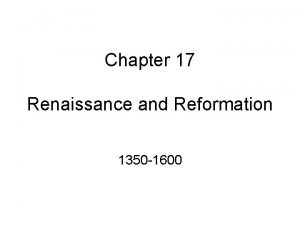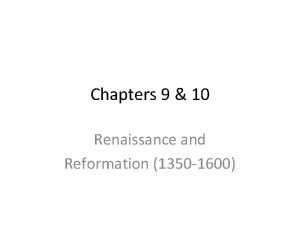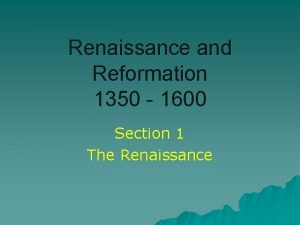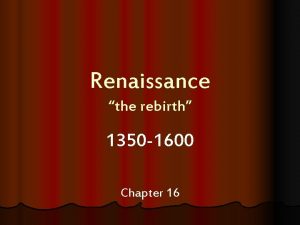The Renaissance 1350 1600 Major Theme After the













- Slides: 13

The Renaissance 1350 - 1600 Major Theme: After the Later Middle Ages, Europe experienced a “rebirth” of commerce, interest in classical cultures, and confidence in human potential.

The Renaissance n Marked the beginning of modern European History n Time Line: 1. Began in Italy, early 1300 s 2. Spread to Northern Europe, c. 1450 3. Lasted in England from 16 th-17 th centuries

The Renaissance n Characteristics: 1. Distinctly different from Middle Ages (19 th c. Swiss historian Jacob Burckhardt) 2. Benefits applied almost exclusively to upper class – little impact on peasants and working class

Italian City-States Five major players: 1. Florence 2. Milan 3. Rome 4. Venice 5. Naples

Rise of the City-States n Northern Italian city-states led the way – Genoa, Venice, Milan – – – n Oligarchies and signori in control by 1300 in most of Italy Trade and banking Urbanization of Italy Politics of the City-States – Competition, not unity § § § – “Balance of power” Disunity led to disaster Diplomatic legacy of the city-states Condottieri – mercenary generals with private armies hired by city-states

Republic of Florence Center of the Renaissance in 14 th 15 th n Dominated by Medici family n Cosimo de Medici (1389 -1464) – ruler of Florence Lorenzo de Medici (14491492) – “The Magnificent”, patron of arts

Duchy of Milan § Ruled by Sforza family after 1450 § Main adversary of Venice and Florence Ludovico Sforza (“il Moro”) – (1452 -1508) – most famous ruler, patron of da Vinci

Rome, the Papal States n Popes served as religious and political leaders n Controlled much of central Italy n Powerful Italian families competed for the Papal office Alexander VI – (1492 -1503) – Borgia family, corrupt & controversial Julius II – (1503 -1513) – “the Warrior Pope”, great patron of the arts

Republic of Venice n Longest-lasting of the citystates – until early 1800 s n International trading power with strong navy

Kingdom of Naples n Only city-state with “King” n Controlled by French – 1266 -1435 n Ruled by Spanish after 1435 n Secondlargest city in Europe in 1500 s

Decline of the City-States n 1494 – French invasions began – support Milan vs. Florence and Naples n 1494 -1559 – Hapsburg-Valois Wars for control of Italy now center of ‘power struggle’ between Spain & the Holy Roman Empire (Hapsburgs) and France (Valois)

Decline of the City-States n n 1494 – Medicis ousted in Florence 1494 -1498 – Girolamo Savonarola – Catholic priest – ruled Florence as a theocracy 1497 – “Bonfire of the Vanities” Savonarola excommunicated and burned at stake, Medicis eventually returned to power

End of the Italian Renaissance n 1527 – Sack of Rome by soldiers of Charles V of HRE n Pope Clement VII imprisoned by Charles V n Destruction of Rome signaled end of Italian Renaissance
 How long ago was the renaissance
How long ago was the renaissance It had long since come to my attention
It had long since come to my attention After me after me after me
After me after me after me After me after me after me
After me after me after me Time of rebirth
Time of rebirth Renaissance history event
Renaissance history event Medieval times commercial
Medieval times commercial Sudut sejajar
Sudut sejajar League of legends jeopardy
League of legends jeopardy 1350 ce
1350 ce Besar salah sudut pusat segi 12 beraturan adalah
Besar salah sudut pusat segi 12 beraturan adalah Koordinat kutub
Koordinat kutub Causes of renaissance
Causes of renaissance Italian renaissance vs northern renaissance venn diagram
Italian renaissance vs northern renaissance venn diagram
